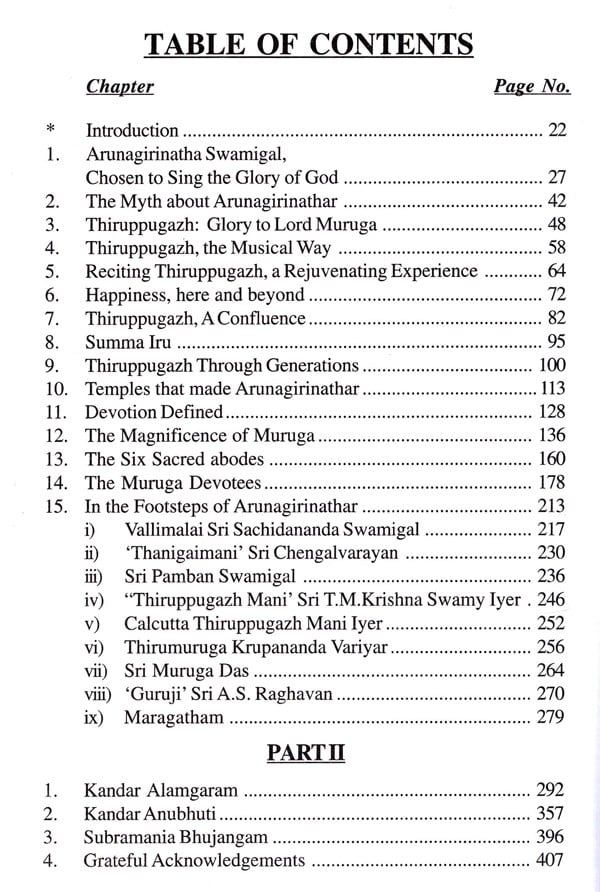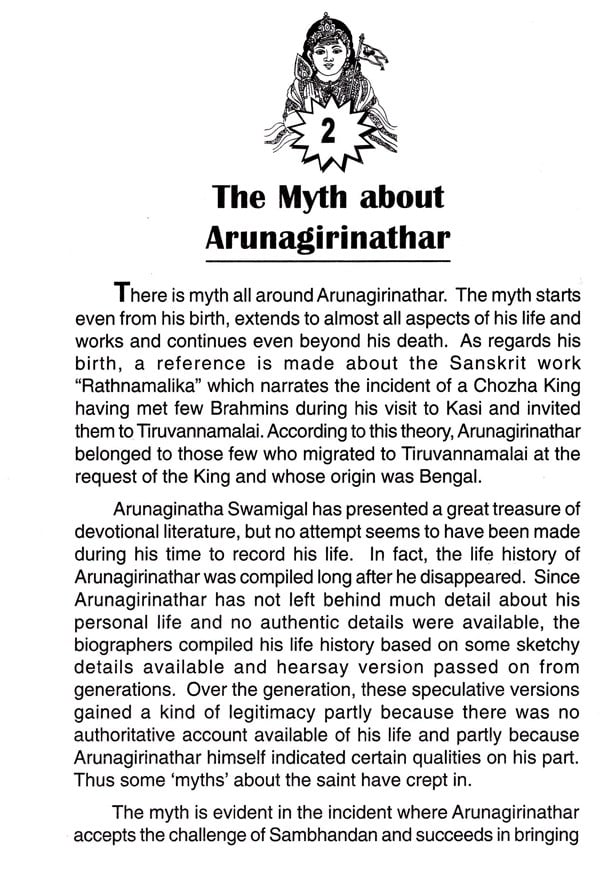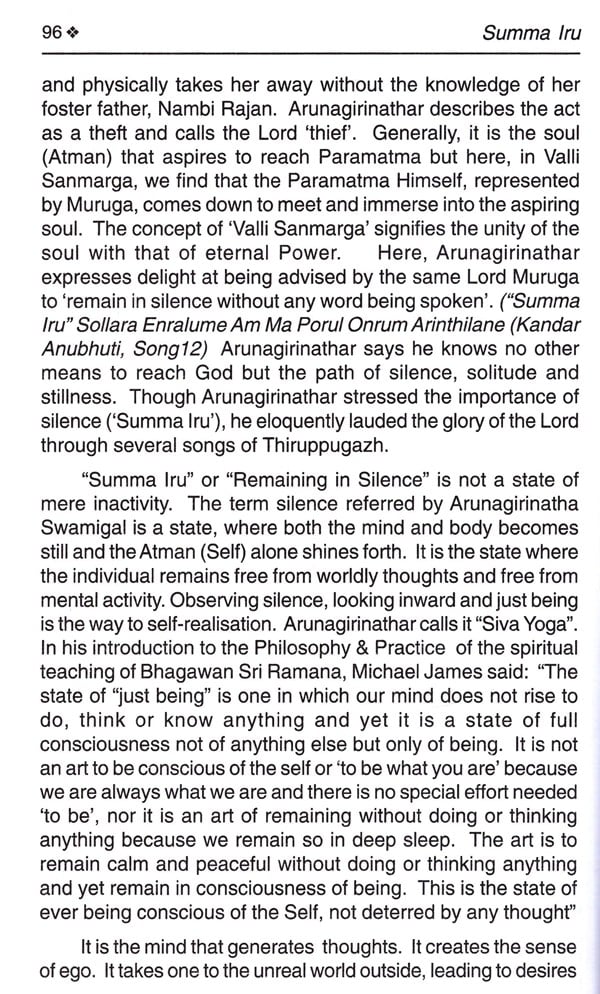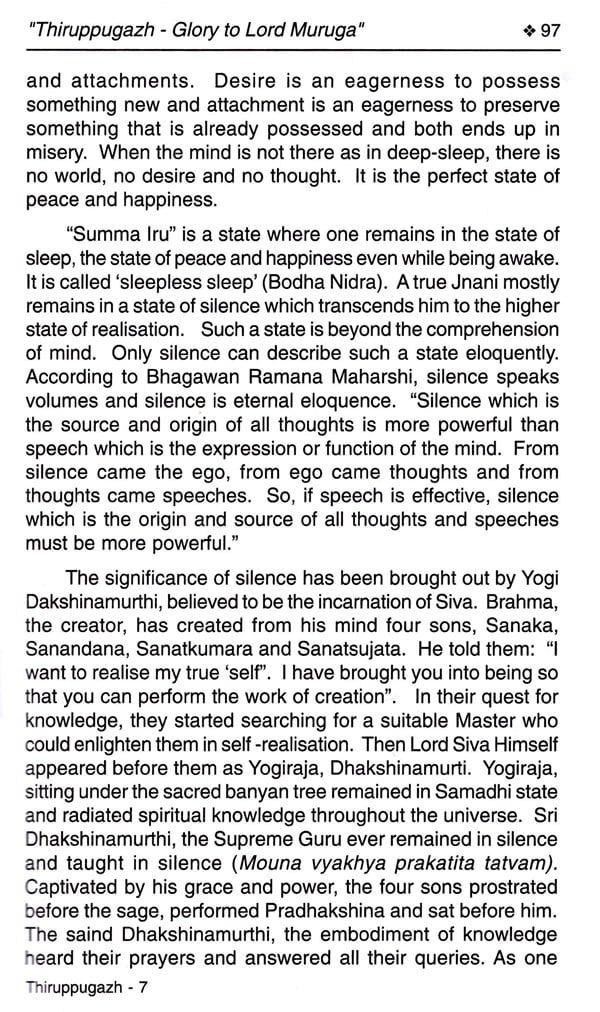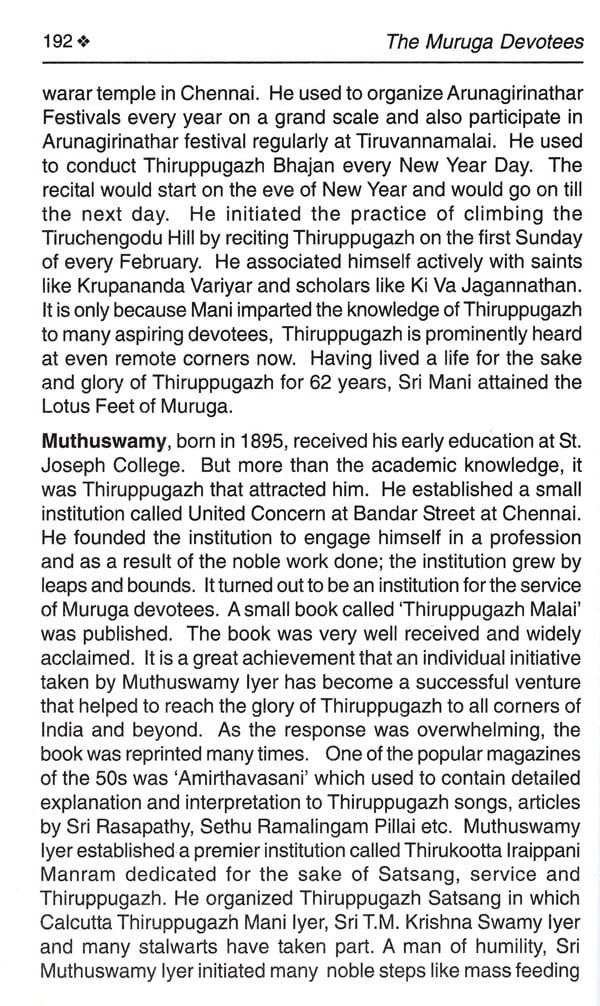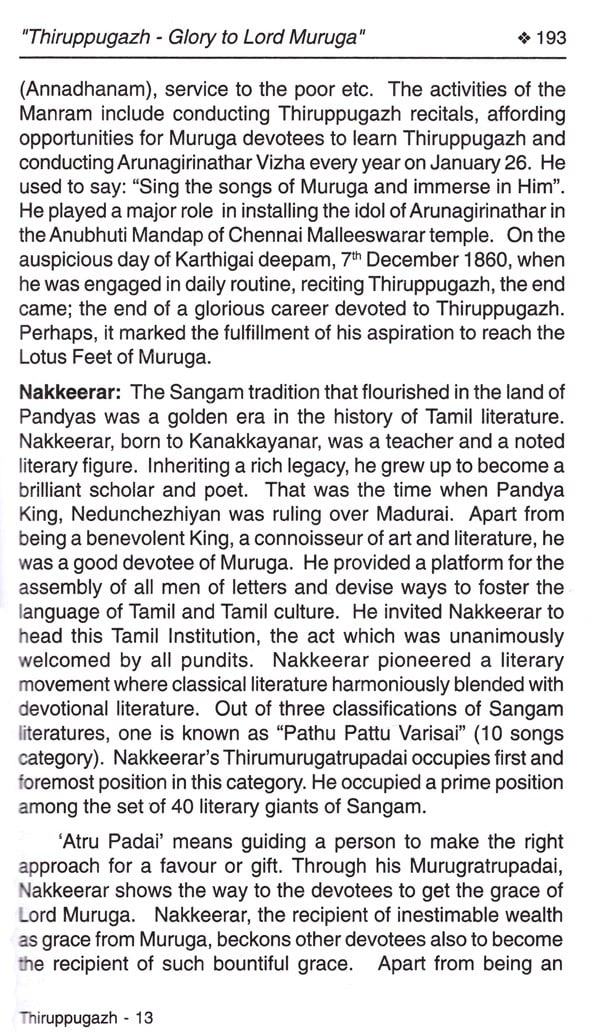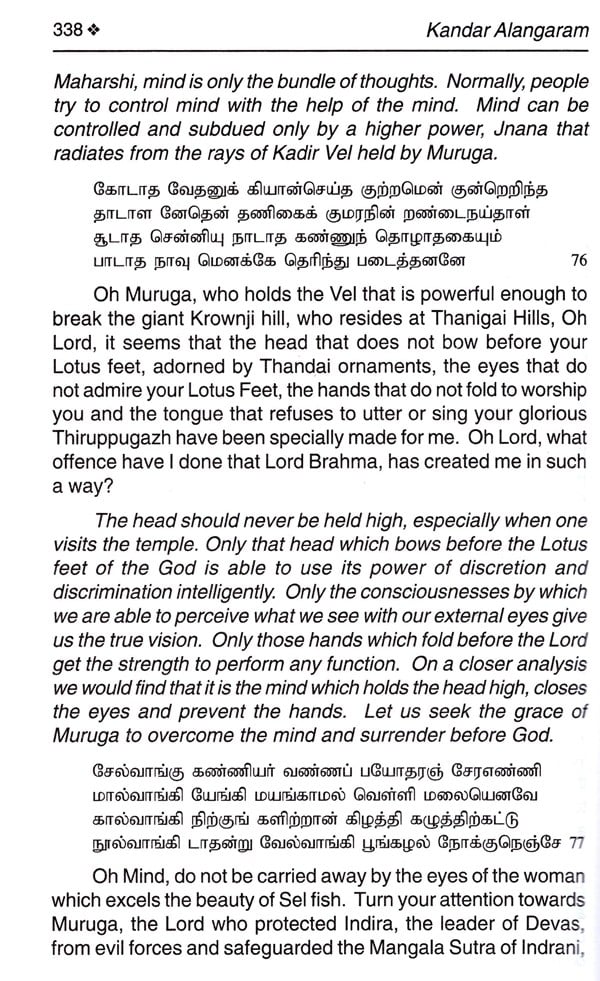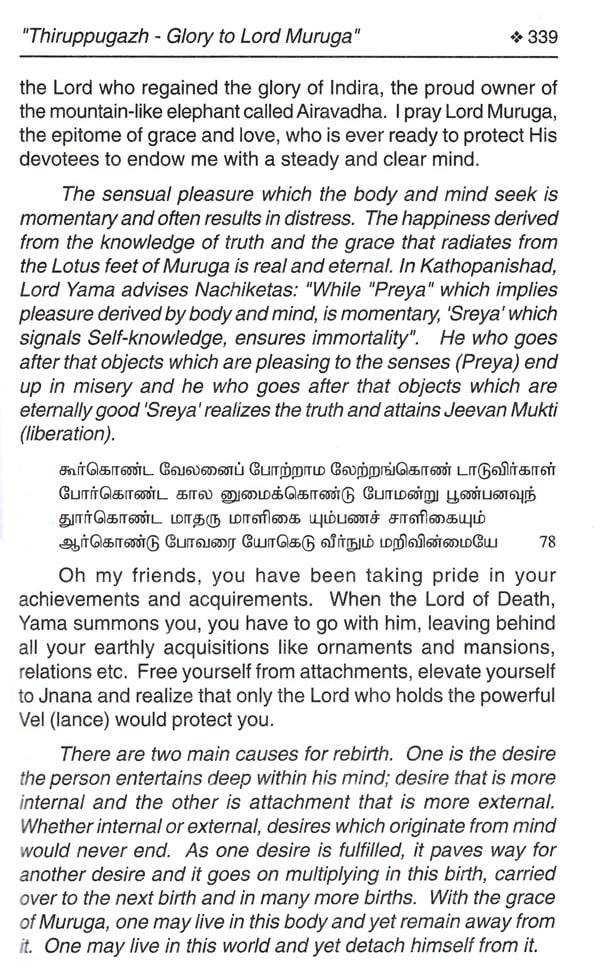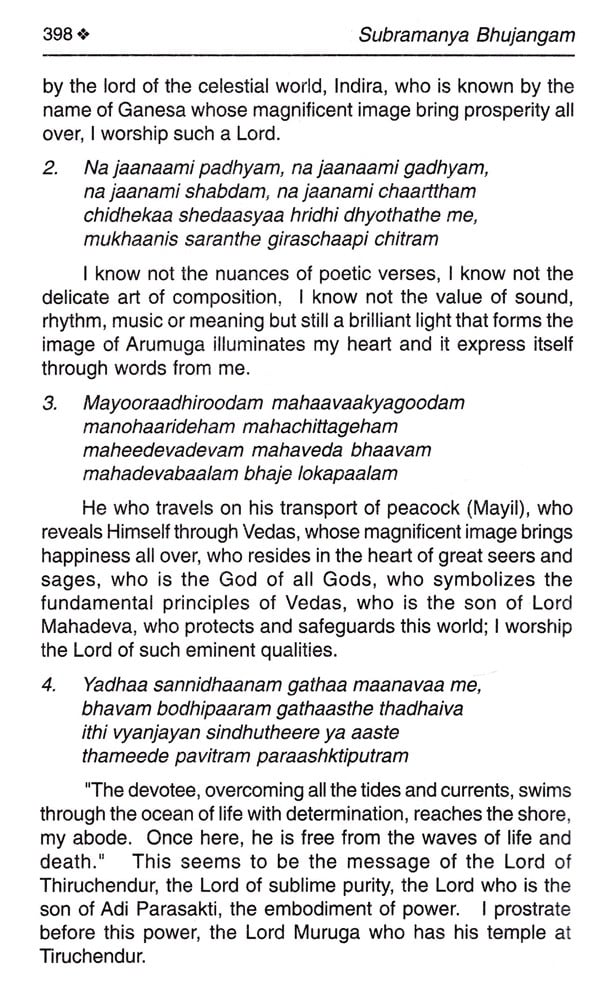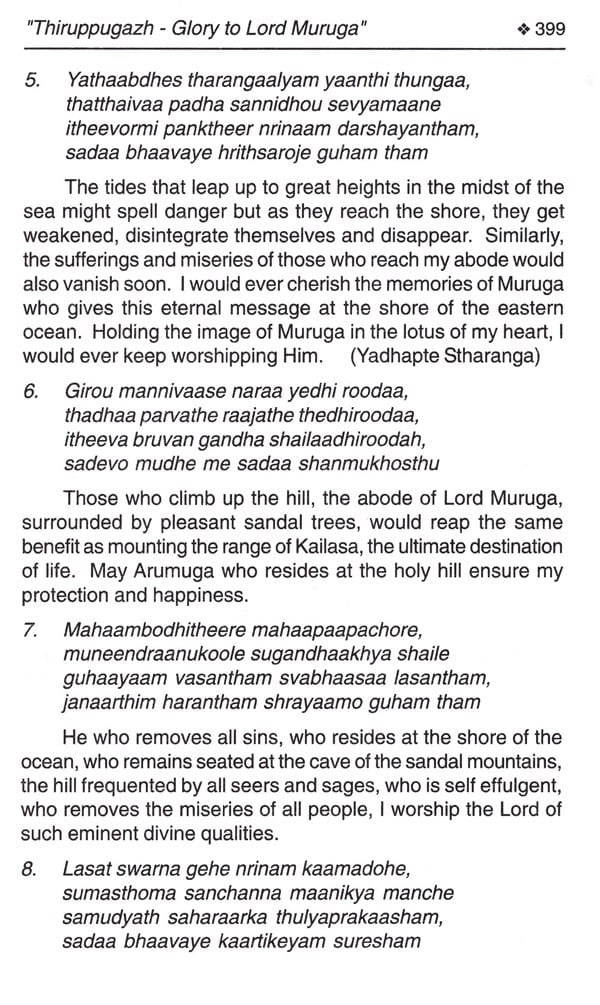
Thiruppugazh: Glory to Lord Muruga
Book Specification
| Item Code: | UAB804 |
| Author: | V.S Krishnan |
| Publisher: | UMA PATHIPPAGAM |
| Language: | English and Tamil |
| Edition: | 2015 |
| Pages: | 408 |
| Cover: | PAPERBACK |
| Other Details | 9.00 X 5.50 inches |
| Weight | 390 gm |
Book Description
The holy town of Palani was readying itself to witness a great occasion, Thaipoosam. The colourful procession of deities and music reverberating in the air, the temple city wore a festive look. Among the multitude of devotees who poured into the town, aspiring to seek the blessings of Lord Dhandayudapani, there was this devotee from Thrissur. He was camping at the premises of his old friend, Muthu lyer. He then happened to hear a music recital at the same premises. If the singer exuded an aura of divinity, the songs he rendered were very soul-stirring. The devotee from Thrissur was so absorbed in the song that he forgot for a while what he came there for. He did not know the meaning of the song but he felt an inexplicable power behind it. There was something in those lyrics that captivated him. The devotee kept listening till the singer completed his recital He then went straight towards the singer and made an unusual request: "Would you please come down to my home at Thrissur"? If the question was rather unusual, the answer that came from the singer-saint, having many engagements to fulfill, also turned out to be unusual. Without even pausing a second, he said "Why Not"? The songs that highlighted the glory of Muruga and kept all the audience spell-bound were the immortal verses of Thiruppugazh, the singer-saint who gave his voice to express them in music was Sri Mani lyer from Calcutta and the devotee and his family members who were blessed to imbibe the nectar of it all was my father, Sri V.M. Subramania lyer. I pay my humble homage to my parents Smt. A. Meenambal and Sri V.M. Subramania lyer who have inculcated the spirit of devotion in my heart right from childhood. It is this devotion that guides me all through my life and that has flowered now in the form of this book.
In Kandar Anuboothi, Arunagirinathar prayed for Muruga to appear before him as a Guru and guide him. (Guruvai Varuvai Arulvai Guhane. The God always descended as a guide and Guru, He appeared as Sri Dakshinamurthi, as Sri Adi Sankara as Sri Ramanuja and as many Acharyas. He appeared as many sages and saints and he appeared as Sri Mani lyer. He came all the way from Palani to our house in Kerala and initiated us to the experience of Thiruppugazh. He kindled the flame of devotion in our hearts. He has given us the song scripts, the Sruthi, the Raga, the Bhava, the devotion and the voice. His words, on the eve of his departure from our house, still reverberate in our hearts: "Thiruppugazh is not a mere set of songs. It is a form of worship, a culture, a way of life, a doctrine and above all a path that would elevate one to the state of liberation. Nourish this culture and pass it on to future generations."
Both of them, my father and the Guru, have departed. The leaves of time have withered. The winds of change have blown all over. Life style changed, priorities changed, outlook changed, but the light of Thiruppugazh that Guru Sri Mani lyer had kindled lives on. His parting words still guide us. The songs still reverberate in our ears. The Thiruppugazh culture he built flourished and went on, beyond time and beyond generations. Years later, when I got to know the full value of it, the eternal message of truth contained in it and the melody of music in it, I realised what a precious treasure that Sri Mani lyer had given; the treasure, which is immeasurable in value and undiminished by time. It was Thiruppugazh that guided me and members of our family all through the life. I pay my humble homage and reverence to Sri Mani lyer through the pages of this book.
When I rendered the verses of Thiruppugazh, as a child, they meant only as beautifully arranged Tamil words in music.
The goal I set in life has changed, environment has changed, and priorities have changed but the seed of Thiruppugazh which Mani lyer planted in my young mind lived on somewhere in the corner of my heart. It remained dormant for about 3 decades of my career in different places in North India, till I reached Chennai, the source of Thiruppugazh, the 'Thai Veddu' as described by Sri Chengalvarayan. Studying the works of pundits like Sri Sengalvaraya Pillai, Sri Krupananda Variyar, Sri Ki Va Jagannathan greatly helped in the germination of the seed. Retirement gave me an opportunity to devote my full time and got me the contact of Thiruppugazh Anbargal, the movement pioneered by Guruji A.S. Raghavan. The plant of Thiruppugazh already flourishing within now bloomed in brilliance. I learned more songs, in the Raga Guruji Sri Raghavan had set them. I went more deep into their meanings. I was swept by the waves that Guruji was creating. While expressing my reverence and respect to 'Guruji' for the guidance and leadership he provides to Thiruppugazh moment, I also wish to thank him personally for the enormous help he rendered in the success of the first edition of this book.
According to Siva Puranam, Lord Siva, the God Supreme, symbolizes the underlying reality of the universe. The universe originated from Siva and it would be absorbed into Siva. He is the Purusha of the Vedas, the celestial male. He manifests as Iswara. Rig Veda, the earliest scripture, refers to Him as Rudra, the term associated with fire. The universe consists of the five elements of fire, air, water, earth and ether and Lord Siva appears to represent these five elements. With Kailash as His abode, Lord Siva appeared in various forms. He appears in form as Nataraja and without form as the underlying reality of the universe. He appears in formless form as Linga at different temples and in the form of Jyothi at twelve different shrines (1). It is difficult to trace the origin of Siva worship as it is difficult to trace of origin of Siva. Right from ancient time, Siva worship was widely prevalent in Asiatic region and particularly in Bharath Varsha. The sacred ash (Vibhuti) is the sign of Saivism and a Siva devotee is identified with this mark on his forehead. While Siva worship developed as Pashupata Shaivism in northern region, it developed as Saiva Sidhanta in South.
Among the many cultures and languages, Tamil devotional literatures have the unique distinction of being the earliest cultivated and highly developed. The seventh and ninth centuries witnessed a phenomenal growth in Siva worship in South India. Arunachala Mahatmyam describes Siva as the Supreme God of the universe.
The saints and scholars composed their works in various categories like 12 Thirumurais in praise of Siva and Divya Prabhandam in praise of Vishnu. The Vaishnavite saints, known as Alwars, established a high tradition of Bhakti and worship. The four-thousand Divya Prabhandam, a collection of hymns sung by different Alwars and compiled by Saint Nathamuni remain as a rich treasure of devotional literature. Nammazhvar, Periyazhvar, Andal, Kulasekara Azhvar, Thirumangai Azhvar effectively highlighted the importance of devotion (Bhakti). Panniru Thirumurai is an excellent collection of devotion that extols the glory of Lord Siva. Composed independently and in combination by 27 saints, these twelve works extend to 18,000 songs and are considered as inexhaustible source of knowledge and devotion. These 12 volumes of epic dimension have no parallel anywhere in the world. Out of the first 7 volumes, referred as Thevaram, three are sung by Saint Thirujnana Sambhandar and three are composed by Saint Thirunavukkarasar and the 7th by Sundaramoorthi Swamigal. The 8th Thirumurai, known as Thiruvachakam was composed by Manikkavachakar.
The 9th volume which goes by the name of Thiruvisaippa and Thiruppallandu hail the glory of Lord Siva. Saint Tirumular, the foremost among them, composed the 10th volume, Thirumandram, which laid out the guidelines for a righteous living. While the eleventh Thirumurai, known as Prabandha Malai, extol the divine qualities of God, the 12th Thirumurai, composed by Sekkeezhar, popularly known as Periya Puranam, portrays the life of 63 Nayanmars. Each Thirumurai has its own devotional, literary and knowledge value. It is believed that these works have been composed by the inspiration of Lord Siva Himself and therefore these works are powerful enough to transcend the devotees to a new world of awakening.
Saiva Sidhantam, a doctrine that views Siva as the ultimate power of the Universe, sought answers to some fundamental questions on life, universe and the underlying link between the two. Though Saiva Sidhantam originated in Northern region, it was developed by Thirumular, an enlightened sage, in South India. According to him, Siva is the cosmic power, the source, origin and cause of all activities in universe. Thirumular composed his classic spiritual work Tirumandram' (Holy garland of Mantras). He was a realised Yogi who attained Jeevan Mukti. Divided into nine chapters, Thirumandram underlines the principles of Saiva Sidhanta. Tirumandram is the 10th among the 12 sacred scriptures known as Panniru Thirumurai. The 63 Nayanmars who came from different fields were all united in devotion towards Siva. Living a life of service and sacrifice, they hailed the glory of Lord Siva in magnificent verses and revitalized the devotional movement. They brought a new impetus to Bhakti movement. The four saints, popularly known as "Nalvar" took the glory of Siva to all time high. Each of them perceived Siva in their own way. Sekkeezhar, a great biographer of Saiva saints, conveyed Lord Siva's own message in the following words.
The seventh century witnessed enormous spiritual activity in Tamil Nadu. The 63 Nayanmars, who lived a life of service and sacrifice, established a great tradition of Siva worship. Among them, the four saints, Sundaramurthi Swamigal, Jnana Sambhandar, Thirunavukkarasar and Manikkavachagar, popularly known as 'Nalvar', hailed the glory of Lord Siva in magnificent verses. The great biographer, Sekkeezhar, portrayed the lives of Saiva saints in his immortal works, Periyapuranam. "God has created me well versed to be able to sing His glory in Tamil" (Ennai Nanraka Iraivan Padaithanan Thannai Nanraka Thamizh Seyyumare); so sung Thirumular. Sri Ramalinga Adigalar, popularly known as Vallalar, a devotee of Lord Chidambaram, established a unique institution, Sudha Sanmarga Sangham, which showed the path of truth, knowledge, love and devotion. Thayumanavar, belonging to 17th century, was one of the great teacher and scholar of Saiva Sidhantam.
A Vaishnavite tradition, based on worship of Lord Vishnu, also developed simultaneously in Tamil Nadu. Saint Ramanujar, the expounder of Visistadvaita, was the strongest advocate of Bhakti movement. When Buddhism and Jainism were trying to establish their hold, it was the Bhakti movement led by Ramanucharya that brought about a Hindu revival. The four thousand Divya Prabhandam, a collection of hymns, composed by Saint Nadamuni and sung by Alwars remain a rich treasure of devotional literature. These are considered as equal in importance as Vedas. Nammazhvar, Periyazhvar, Andal, Kulasekara Azhvar, Thirumangai Azhvar and many other Alwars took Bhakti movement to an all time high.
These two philosophies, Saivism and Vaishnavism, went almost on parallel lines; each on its own direction, creating a sort of division in the Hindu way of live. It was inconceivable that Sanatana dharma, based on the principle of universal brotherhood, should limit itself to certain boundaries. It was Arunagirinathar, the author of Thiruppugazh, who broke this boundary wall and established the unity of all forms of worship. Arunagirinathar believed that all forms and names are varied manifestations of one Supreme Being. Though he was basically a Siva devotee and revitalised Muruga worship, he sought to integrate both the Saiva and Vaishnava schools into one single doctrine. Being a Siva devotee by heart, he would have addressed Muruga as Siva Kumara but instead he addressed Muruga as 'Thirumalin Marugone' (as one who has married the daughter of Vishnu). He addressed Muruga as "Mal Maruga', as another form of Perumal. He found as much joy in singing the glory of Vishnu as that of Siva. He visualised Muruga admiring young Krishna's 'mischiefs' of stealing butter (Navaneethamum Thirudi...song: Sivanar Manam Kulira). The poet of Tiruvannamalai elaborately described the events of Ramayana in various songs. (Udukka Thukil Vendum). Episodes from Vishnu Avatars like Narasimha and Vamana are also found in Arunagirinathar's songs. In Kandar Alamgaram he describes Muruga as the son in law of Lord Vishnu. "Oh Muruga, who has married the daughter of Vishnu," he says in his song 'Malon Marugane', "the connoisseur of the divine art of dance at the Court of Devas, the Lord most adored and worshipped by Devas, the epitome of knowledge, who resides at Tiruchengodu, the abode surrounded by lush green paddy fields and lakes, how fabulous and magnificent you look! Even if Lord of Creation, Brahma, has endowed me with four thousand eyes, it would not be enough to see and admire your majesty and splendor to my heart's content." Arunagirinathar has sought to build bridges between the two sets of worship, synthesized them by highlighting the one underlying reality behind them.
Thiruppugazh is a marvelous creation of Arunagirinathar. It is a gate-way to the path of knowledge and devotion. I appreciate the efforts taken by Sri V.S. Krishnan in bringing out this revised version of his book "Thiruppugazh: Glory to Lord Muruga". He has added many additional features in this book and I am sure this would be of good use to those intending to follow the path shown by Arunagirinathar, the path trodden by many saints, seers and singers.
**Contents and Sample Pages**
